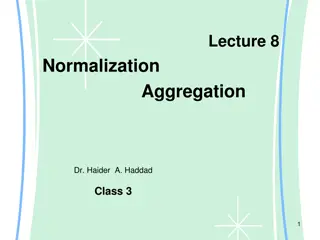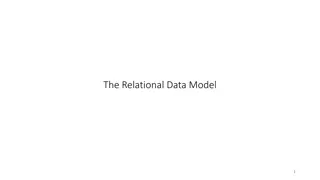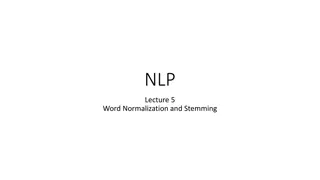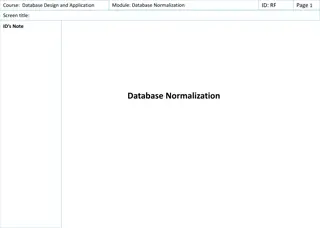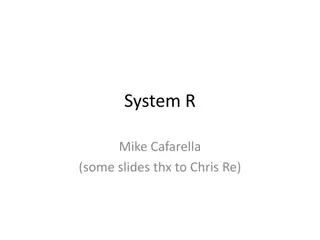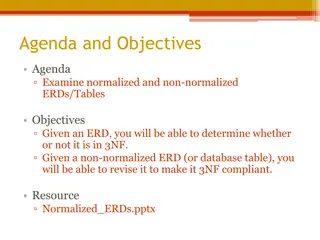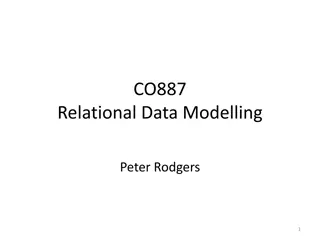Relational Database Management System Normalization
Normalization is a process in database organization to avoid redundancy, insertion, update, and deletion anomalies. It involves organizing data into tables to ensure unambiguous results. Types of normalization include First Normal Form (1NF), Second Normal Form (2NF), Third Normal Form (3NF), Boyce-Codd Normal Form (BCNF), Fourth Normal Form (4NF), and Fifth Normal Form (5NF). Each normalization form has specific criteria to structure data efficiently.
Uploaded on Apr 16, 2025 | 0 Views
Download Presentation

Please find below an Image/Link to download the presentation.
The content on the website is provided AS IS for your information and personal use only. It may not be sold, licensed, or shared on other websites without obtaining consent from the author.If you encounter any issues during the download, it is possible that the publisher has removed the file from their server.
You are allowed to download the files provided on this website for personal or commercial use, subject to the condition that they are used lawfully. All files are the property of their respective owners.
The content on the website is provided AS IS for your information and personal use only. It may not be sold, licensed, or shared on other websites without obtaining consent from the author.
E N D
Presentation Transcript
UNIT 4 RELATIONAL DATABASE MANAGEMENT SYSTEM NORMALIZATION & TYPES OF NORMALIZATION By Miss. T. Sarah Jeba Jency, M.Sc., M.Phil., B.Ed.,
1) DEFINE NORMALIZATION Normalization can be defined as :- A process of organizing the data in database to avoid data redundancy, insertion anomaly, update anomaly & deletion anomaly. A process of organizing data into tables in such a way that the results of using the database are always unambiguous and as intended. Such normalization is intrinsic to relational database theory. It may have the effect of duplicating data within the database and often results in tables. the creation of additional Types of Normalization First Normal Form (1NF) Second Normal Form (2NF) Third Normal Form (3NF) Boyce-Codd Normal Form (BCNF) Fourth Normal Form (4NF) Fifth Normal Form (5NF)
First Normal Form (1NF) First normal form enforces these criteria: Eliminate repeating groups in individual tables. Create a separate table for each set of related data. Identify each set of related data with a primary key Table_Product Colour Product Id Price This table is not in first normal form because the Colour column contains multiple Values. 1 Black, red Rs.210 2 Green Rs.150 3 Red Rs. 110 4 Green, blue Rs.260 5 Black Rs.100
After decomposing it into first normal form it looks like: Product_id Price Product_id 1 1 2 3 4 4 5 Colour Black Red Green Red Green Blue Black 1 Rs.210 2 Rs.150 3 Rs. 110 4 Rs.260 5 Rs.100
Second Normal Form (2NF) A table is said to be in 2NF if both the following conditionshold: Table is in 1NF (First normal form) No non-prime attribute is dependent on the proper subset of any candidate key of table. An attribute that is not part of any candidate key is known as non-prime attribute. Table purchase detail Customer_id Store_id 1 1 2 3 4 This table has a composite primary key i.e. customer id, store id. The non key attribute is location. In this case location depends on store id, which is part of the primary key. Location Patna Noida Patna Delhi Noida 1 3 1 2 3
After decomposing it into second normal form it looks like: Table Purchase Customer_id 1 1 2 3 4 Table Store Store_id 1 2 3 Store_id 1 3 1 2 3 Location Patna Delhi Noida
Third Normal Form (3NF) A table design is said to be in 3NF if both the following conditionshold: Table must be in 2NFTransitive functional dependency of non-prime attribute on any super key should be removed. An attribute that is not part of any candidate key is known as non-prime attribute. In other words 3NF can be explained like this: A table is in 3NF if it is in 2NF andfor each functional dependency X-> Y at least one of the following conditionshold: X is a super key of table Y is a prime attribute of table An attribute that is a part of one of the candidate keys is known as prime attribute.
THIRD NORMAL FORM Table Book Details Bood_id In the table, book_id determines genre_id and genre_id determines genre type. Therefore book_idd determines genre type via genre_id and we have transitive functional dependency. Genre_id Genre type Fiction Sports Fiction Travel sports Price 1 2 3 4 5 1 2 1 3 2 100 110 120 130 140 After decomposing it into third normal form it looks like: TABLE BOOK Book_id 1 2 3 4 5 Genre_id 1 2 1 3 2 Price 100 110 120 130 140 TABLE GENRE Genre_id 1 2 3 Genre type Fiction Sports Travel
Boyce-Codd Normal Form (BCNF) It is an advance version of 3NF that s why it is also referred as 3.5NF . BCNF is stricter than 3NF . A table complies with BCNF if it is in 3NF and for every functional dependency X->Y, X should be the super key of the table. KEY: {Student, Course} Student Course Teacher Functional dependency Aman DBMS AYUSH {student, course} -> Teacher Aditya DBMS RAJ Teacher-> Course Abhinav E-COMM RAHUL Problem: teacher is not superkey but determines course. Aman E-COMM RAHUL abhinav DBMS RAJ
After decomposing it into Boyce-Codd normal form it looks like: Student Aman Aditya Abhinav Aman Abhinav Course DBMS DBMS E-COMM E-COMM DBMS Course DBMS DBMS E-COMM Teacher AYUSH RAJ RAHUL
Fourth Normal Form (4NF) Fourth normal form (4NF) is a level of database normalization where there are no non-trivial multivalued dependencies other than a candidate key. It builds on the first three normal forms (1NF , 2NF and 3NF) and the Boyce- Codd Normal Form (BCNF). It states that, in addition to a database meeting the requirements of BCNF , it must not contain more than one multivalued dependency. Student Aman Aman Raj Raj Ram Aditya Abhinav Major Management Management Management Medical Management Btech Btech Hobby Football Cricket Football Football Cricket Football Cricket Key: {students, major, hobby} MVD: ->-> Major, hobby
After decomposing it into fourth normal form it looks like: Student Aman Raj Raj Ram Aditya Abhinav Major Management Management Medical Management Btech Btech Student Aman Aman Raj Ram Aditya Abhinav Hobby Football Cricket Football Cricket Football Cricket
Fifth Normal Form (5NF) A database is said to be in 5NF , if and only if, It's in 4NF . If we can decompose table further to eliminate redundancy and anomaly, and when we re-join the decomposed tables by means of candidate keys, we should not be losing the original data or any new record set should not arise. In simple words, joining two or more decomposed table should not lose records nor create new records. Seller Aman Company Coca cola company Product Thumps Up Key: {seller, company, product} Aditya Aditya Aditya Abhinav Abhinav Unilever Unilever Uniliver P&G Pepsico Ponds Axe Lakme Vicks Pepsi MVD: Seller ->-> Company, product Product is related to company.
After decomposing it into fifth normal form it looks like: Seller Aman Aditya Aditya Aditya Abhinav Abhinav Product Thumps Up Ponds Axe Lakme Vicks Pepsi Seller Aman Company Coca cola company Aditya Abhinav P&G Abhinav Pepsico Unilever Company Coca cola company Unilever Unilever Unilever Pepsico P&G Product Thumps Up Ponds Axe Lakme Pepsi Vicks


